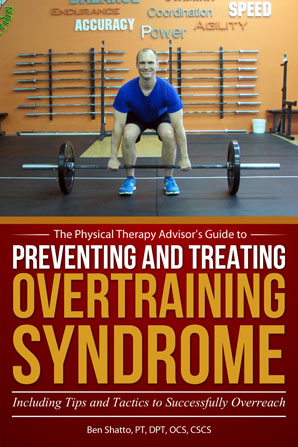Overreaching is a training strategy used to build strength and/or performance. It describes an acute training phase where you temporarily increase the training volume, load and/or intensity as part of a specific training strategy to gain a specific training outcome. Overreaching can be an effective and important part of a training cycle when properly programed. It typically results in additional fatigue and soreness. Upon recovery, the desired outcome is an obvious improvement or “supercompensation” in that specific sport or activity.

When used appropriately, overreaching is an important component of high-quality training although there is the potential of developing Overtraining Syndrome (OTS). Overreaching is an advanced training concept and should not be utilized by novice individuals regardless of the sport or activity overreaching is occurring in.
Why risk Overtraining Syndrome (OTS) to incorporate Overreaching into your training?
- Overreaching helps your body to perform the extra steps needed to produce more results in a shorter period of time.
- Overreaching helps you to “shock” the body in order to get results by shortening the time (days to weeks) in which you push yourself to a state of being nearly overtrained before backing off. This is more than the typical overload you are attempting with regular training.
- Supercompensation occurs as you push yourself right up to your limit. This allows you to surpass prior limits for short periods of time. It may help you advance your training to a higher level.
- Quality intermediate to advanced training plans incorporate a stair step increase in performance with 3-4 intermittent bouts of overreaching throughout a typical periodized training year. Make sure that your training plan is right for you.
Tips to help you safely overreach:
Do not attempt if you are a novice. Overreaching is an advanced technique for intermediate to advanced individuals.
- A planned and programmed overreaching session should last no longer than 1-2 weeks.
- Increase your training and/or intensity and/or volume tactically and strategically, but not more than 40%.
- Watch for symptoms of Overtraining Syndrome. Symptoms may include becoming fatigued sooner during the workout or experiencing excessive fatigue or soreness. Depending on how much longer in the phase you need to progress, you may need to discontinue your overreaching training plan and initiate your recovery protocol.
- During the overreaching cycle, extra care and planning should be taken so you can work hard at recovery between each bout of exercise. Specific recovery strategies are outlined in my book, Preventing and Treating Overtraining Syndrome.
- Once your recovery time is over, continue with your training plan. Take note of where you are and how you feel in your training. If you are feeling good and are demonstrating improvement, adjust your training plan by appropriately tapering up the volume and/or intensity to match your added gains. This is how supercompensation can help your training and performance reach new levels.
Overreaching can be an excellent method to speed up and more quickly advance in your training. However, there is the risk of overdoing and developing Overtraining Syndrome (OTS). Overreaching should be performed carefully and thoughtfully as part of a complete training plan. Overreaching should always be followed with an equally thought out rest and recovery protocol.
Discover how to best utilize overreaching as a powerful training strategy so that you can continue to train hard and avoid the associated poor performance, illness, and injury that can result in lost training days and opportunity!

AVAILABLE NOW ON AMAZON!
In my book, Preventing and Treating Overtraining Syndrome, I show you how to recognize the risk factors and symptoms of OTS. You’ll learn how to utilize prevention strategies to help you develop a personal training strategy that will allow you to push past your limits and prior plateau points in order to reach a state of what is known as overreaching (your body’s ability to “supercompensate”). This will speed up your results, so that you can train harder and more effectively than ever before! In addition, learn how to use the foam roller (complete with photos and detailed exercise descriptions) as part of a health optimization program, recovery program, rest day or treatment modality.
